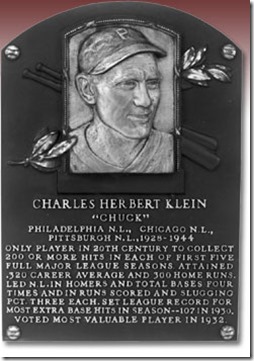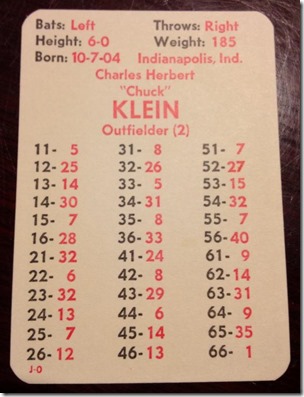Have I really not done a Chuck Klein Monster Card yet? Really? I found that hard to believe when I looked back to check. I know I’ve written about him when Brando and I played his 1930 replay and I know Pastor Rich did his duty by recommending him. But nope, I haven’t done an official Monster Card Monday column on the Indy-born rightfielder. Let’s take care of this now.
To APBA fans, Klein is most known as the slugger who led one of the most potent offenses for a last place team. In 1930, Klein’s Phillies batted .315 as a team yet finished in the cellar with a dismal 52-102 record. It goes without saying that the Phils’ pitching left something to be desired. With a team ERA of 6.71and walking 543 while striking out just 384, they couldn’t keep up with the rest of the National League who was also hitting the cover off the ball.
Klein did his part though. In 1930, he collected 250 hits for a .386 batting average while playing everyday. He cracked 40 homers and added 59 doubles and 8 triples. He led the league with 158 runs and 445 total bases. In any other year, Klein’s 170 rbis would have led the league but that was the year of Hack Wilson’s record breaking effort.
| Split | G | PA | AB | R | H | 2B | 3B | HR | RBI | SB | BB | SO | |||
|---|---|---|---|---|---|---|---|---|---|---|---|---|---|---|---|
| 1930 Totals | 156 | 721 | 648 | 158 | 250 | 59 | 8 | 40 | 170 | 4 | 55 | 50 | .386 | .437 | .687 |
Any offensive-minded APBA player would have fun with this card. Klein’s power numbers of 1-5-5-6-6 rival Ruth and Wilson especially with runners on base. His overall numbers of four 7s, three 8s, and two 9s give him a juicy 51-7.
Klein isn’t your typical slugger either. He only has two 13s to go with his three 14s.
At first glance, it may seem a bit odd that Klein’s 40 homeruns doesn’t warrant double ones. I realize that he played every day and accumulated 721 plate appearances so I thought I would do the math.
40 HR in 721 PA = 1.997 HR per 36 PA
So essentially he should get the equivalent of two first column 1s. I remember from my APBA Journal reading that a 5 is roughly equal to .35 of a single column 1 (if memory serves, a 6 is equal to .03 also).
Everything is relative and depends on circumstances. Klein batted third and fourth for the ‘30 Phillies and most likely had runners on base. Still, a 1-5-5-6-6 gives him an estimated 1.78 homeruns per 36 PA well below the two 1s he probably deserves. Did he get downgraded because he was on a last place team? Maybe.
Fun numbers: 44-6, 51-7, 61-9
 Chuck Klein never did see the postseason with the Phillies though he did play in the World Series in 1935 with the Cubs. He went 4 for 12 with a homer against the Tigers.
Chuck Klein never did see the postseason with the Phillies though he did play in the World Series in 1935 with the Cubs. He went 4 for 12 with a homer against the Tigers.
Klein eventually made the Hall of Fame via the Veteran’s Committee in 1980. While he played a total of 17 seasons in baseball, one could easily argue that he made it on the strength of his early years of 1929-1933 with Philadelphia. After that, he was solid offensively but he never hit more than 25 homeruns and only surpassed 100 rbis once.
But during that five year stretch, Klein was a monster. During that time, he batted .359 and averaged 36 homers per year. In that period, he led the NL four times in homeruns, twice in rbis, and three times in runs scored.
Probably the biggest stat.. he averaged 396 total bases for those five years. Slugger era or no, that’s a pretty impressive number considering that only 36 players in the history of baseball have eclipsed that mark for even just one season.
Thanks Pastor Rich!





As always, you are welcome!
Possibilities for the lower than expected HR numbers:
1) It’s a misprint or a mistake. Perhaps he was meant to be a 1-1-5 but the intention never made it to the card. Or maybe his numbers were just miscalculated.
2) His 5s, and possibly even 6s, are worth more than most players’ 5s, since he batted behind Lefty O’Doul’s .450+ OBP. The 1.78 HR expectation is based on a historically normal distribution of base-state opportunities. You ain’t getting that with the 1930 Phillies.
3) This is an OFAS1 card, not a season-set card. Maybe those were calculated differently. OTOH, they might be the same; this is 1982, after all, and Seitz might have just taken cards from released sets and made an all-star set from them.
4) Deliberate downgrade. I dismiss this out of hand. Seitz might have been a huge Klein fan during those years, and what cardmaker would downgrade a boyhood hero? Plus, again, this is a special, all-star set. Chicks dig the long ball, and so do customers. If Seitz was putting his thumb on the scale with OFAS1, he probably would have gone in the other direction and made the tables as eye-catchingly juicy as possible.
Just a thought.
Beignet,
all good points.
As to #4, there was this vague rumor that Philly players occasioally got favored in the past because of Lancaster’s geographic proximity. No proof but pure projection.
as to point #3, Klein’s card published in 1989 (shown here http://www.apbablog.com/replay/having-fun-with-brandos-1930-replay) also has him as a 1-5-5-6-6.
I also thought about Lefty O’Doul and his OBP.
When typing his numbers out for the article, I inadvertently typed out 1-1-5-6-6 till I double checked. Maybe APBA did the opposite. :)